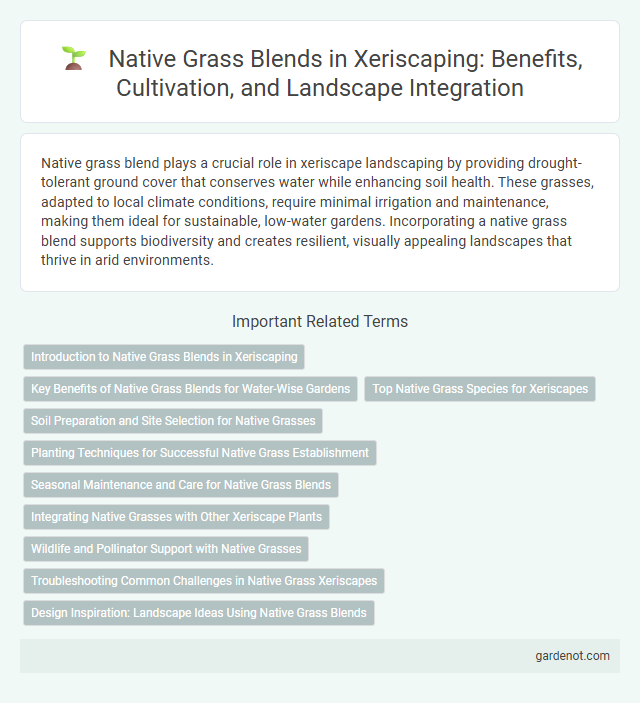Native grass blend plays a crucial role in xeriscape landscaping by providing drought-tolerant ground cover that conserves water while enhancing soil health. These grasses, adapted to local climate conditions, require minimal irrigation and maintenance, making them ideal for sustainable, low-water gardens. Incorporating a native grass blend supports biodiversity and creates resilient, visually appealing landscapes that thrive in arid environments.
Introduction to Native Grass Blends in Xeriscaping
Native grass blends in xeriscaping consist of drought-tolerant species like blue grama, buffalo grass, and little bluestem that establish deep root systems to conserve soil moisture and reduce irrigation needs. These blends enhance soil stability, support local wildlife habitats, and adapt well to arid climates, making them ideal for sustainable landscape design. Incorporating native grass blends promotes water-efficient landscapes that thrive naturally while minimizing maintenance and resource consumption.
Key Benefits of Native Grass Blends for Water-Wise Gardens
Native grass blends enhance water-wise gardens by significantly reducing irrigation needs, as deep root systems improve soil moisture retention and drought resilience. These blends promote biodiversity by providing habitat for pollinators and beneficial insects, supporting ecosystem health. Low maintenance requirements and natural adaptability make native grasses an eco-friendly choice for sustainable landscaping.
Top Native Grass Species for Xeriscapes
Top native grass species for xeriscapes include Blue Grama (Bouteloua gracilis), Buffalo Grass (Bouteloua dactyloides), and Sideoats Grama (Bouteloua curtipendula), known for their drought tolerance and low water requirements. These grasses thrive in arid environments, support local wildlife, and reduce irrigation needs, making them ideal for sustainable landscaping. Selecting native species promotes soil health and minimizes maintenance while enhancing the natural beauty of xeriscape gardens.
Soil Preparation and Site Selection for Native Grasses
Selecting well-drained, sandy or loamy soil with low fertility is essential for establishing a native grass blend in xeriscape landscaping. Proper soil preparation includes removing weeds, loosening the soil to a depth of 6-8 inches, and incorporating organic matter or compost to improve aeration and moisture retention. Choosing a site with full sun exposure and minimal shade maximizes the growth potential of drought-tolerant native grasses, ensuring a sustainable and low-maintenance xeriscape environment.
Planting Techniques for Successful Native Grass Establishment
Planting techniques for successful native grass establishment in xeriscape landscapes include site preparation by removing existing vegetation and loosening soil to enhance root penetration. Applying seeds at the recommended depth and using a native grass blend tailored to local climate conditions ensures maximum germination and drought tolerance. Irrigation should be minimal but consistent during the initial establishment phase to promote deep rooting and long-term sustainability.
Seasonal Maintenance and Care for Native Grass Blends
Native grass blends require minimal seasonal maintenance, thriving with annual mowing and occasional watering during prolonged dry spells. Proper care involves removing dead foliage in early spring to promote healthy new growth and prevent disease. Fertilization is rarely necessary, as native grasses are adapted to local soil conditions, making them a sustainable choice for xeriscaping.
Integrating Native Grasses with Other Xeriscape Plants
Integrating native grasses with other xeriscape plants enhances water efficiency and promotes biodiversity in drought-tolerant landscapes. Native grass blends, including species like blue grama and buffalo grass, complement drought-resistant shrubs and succulents by providing texture and seasonal movement. Combining these plants creates a resilient, low-maintenance garden that thrives with minimal irrigation.
Wildlife and Pollinator Support with Native Grasses
Native grass blends in xeriscaping create vital habitats that support wildlife by providing food, shelter, and nesting sites for diverse species. These grasses enhance pollinator populations by offering nectar and pollen throughout the growing season, which is crucial for bees, butterflies, and other beneficial insects. Utilizing native grasses in landscaping not only conserves water but also restores ecological balance by fostering biodiversity and sustaining pollinator health.
Troubleshooting Common Challenges in Native Grass Xeriscapes
Native grass blends in xeriscapes can face challenges such as uneven germination, pest infestations, and poor soil drainage. Addressing these issues requires using high-quality seed blends adapted to the local climate, implementing proper irrigation schedules tailored to drought-tolerant species, and improving soil structure with organic amendments to enhance water retention. Regular monitoring for pests and diseases, combined with targeted treatments, helps maintain healthy growth and sustainable xeriscape landscapes.
Design Inspiration: Landscape Ideas Using Native Grass Blends
Native grass blends offer a sustainable foundation for xeriscape landscapes, combining drought-tolerant species like buffalo grass and blue grama to create low-maintenance, resilient groundcovers. These blends provide textural variety and seasonal interest with their flowing seed heads and subtle color shifts, enhancing naturalistic design themes. Incorporating native grasses into garden beds, borders, or open spaces supports local ecosystems and reduces irrigation needs while delivering an aesthetically pleasing, eco-friendly landscape.
Native grass blend Infographic

 gardenot.com
gardenot.com